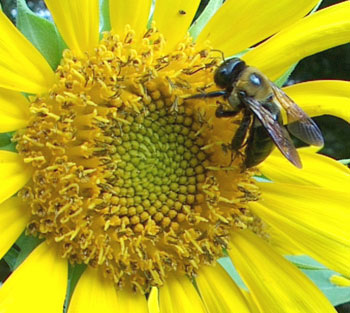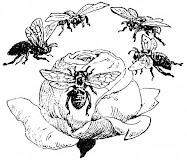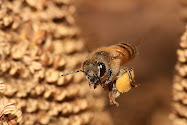
July - A Bee’s World
The queen pokes her head into the cell, sizes up the situation, and determines the type of egg to lay. Smaller cells house fertilized eggs that will develop into female worker bees and slightly larger cells receive unfertilized eggs that will become male drones. It’s the first instance of how the bee’s environment impacts its life, even before it enters the world.
Once hatched, the worker bee spends the first couple of weeks of its life inside the fascinating architecture of the hive. The hexagonal comb pattern leaves no wasted gaps, and the cells are capable of storing everything needed by the colony, including developing brood, pollen, nectar, and honey. Depending on its age and current role, the interior worker bee tends to the contents of these cells.
Our hives at the apiary are based on the movable frame design pioneered by Rev. Lorenzo Langstroth. His discovery of “bee space”, the ideal gap between frames, ~ 3/8”, allowed for removal of frames without destroying comb. Bees control their colony’s environment quite precisely, and any bee space violations will be quickly remedied. Gaps smaller than 3/8” will be filled with propolis and larger gaps will be filled with honeycomb.
Honeybee colonies are not autotrophs and rely on the plant world outside of the hive for sustenance. In his blog, Kim Flottum recently estimated how much bees eat. As he put it, “the rule of thumb is that it takes an acre of flowers to feed a colony of bees. But that's a constant acre of bloom to feed a colony of bees, not just a field of dandelions blooming in May then gone and the bees have enough for the rest of the year. Nope, doesn't work that way.” It’s clear that the ½ acre garden around our apiary won’t be sufficient for the multiple hives on site even if we plant as densely as possible, up vertically, and with a well-timed succession of blooms. The bees will forage elsewhere, expanding their world in search of their continuous acre of flowers. Another general rule of thumb is that they’ll go anywhere from 1-2 miles to find them.
For most bees in a stationary hive, this foraging zone represents the limits of their world. But queens and drones may travel further to drone congregation areas. As the name implies, these are places the drones gather in hopes of mating with a virgin queen. They tend to stay established over multiple years—and many generations of drones—and it’s still unknown how queens find them. For additional reading, Bee Culture sums up the state of our understanding of drone congregation areas.
That’s the world as the bee might experience it. In an upcoming Pollinator Periscope we’ll look at the beekeeper’s world--the larger, more abstract areas that also impact the hive.
--
Recently blooming plants that are hopefully in your local bee colony’s foraging area: sunflowers, blazing star, bee balm, oregano, lemon balm, echinacea.




No comments:
Post a Comment